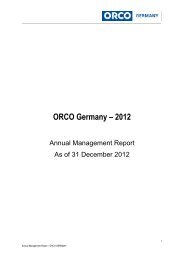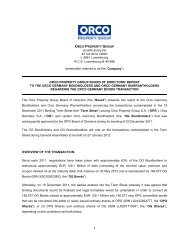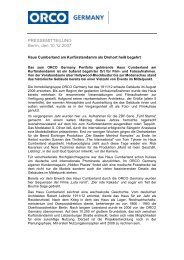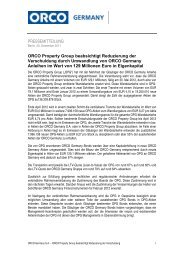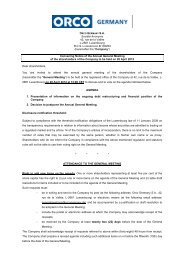Create successful ePaper yourself
Turn your PDF publications into a flip-book with our unique Google optimized e-Paper software.
���������������<br />
�����������������<br />
Timid, provincial – Edzard Reuter was firm and vocal in his convictions<br />
about the future of this inner-city hotspot in the then freshly<br />
reunified Berlin. A maximisation of size and height, said the CEO<br />
of Daimler Benz AG at the time, would recall the legendary area in<br />
its pre-War period. What others had come up with, on the other<br />
hand, was a collage of high-rises, arcades and cinemas - Las Vegas,<br />
Swabian-style.<br />
This faith in the mythology of the area can now be seen as naïve.<br />
Commerce and consolidation alone do not create the perfect urban<br />
setting - a first-class neighbourhood also needs first-class entertainment.<br />
Anybody who has decided, for example, during the Berlinale,<br />
to go for a drink away from the organized catering, will know exactly<br />
what I mean.<br />
Although Leipziger Platz and Potsdamer Platz have managed to<br />
transform themselves from »nothing« in the divided city into a pivotal<br />
point between Mitte and City West, this double square still<br />
lacks the second-line urban structure needed to create a real urban<br />
atmosphere.<br />
Splitting up the »Octagon« (as the square was once known) also<br />
failed to add value. The imposing façades conceal neither city aristocracy<br />
nor bourgeoisie, nor even spectacular establishments, such<br />
as, at one time, the »Haus Vaterland« or »Café Josty«. The imposing<br />
surrounding buildings have also played their part in undermining<br />
the attractive Baroque effect.<br />
The size of the last undeveloped plot offers the opportunity to<br />
transform this currently desolate square into a vibrant spot in the<br />
city. An exciting structure running the depth of the block could<br />
once again stand on the site of the legendary Wertheim department<br />
store, created by the architect Alfred Messel. A place for open, urban,<br />
contemporary society, especially in a city like Berlin, which has little<br />
civic background.<br />
Berlin was created at random; the crucial impetus for a city was<br />
provided by self-made men such as August Borsig and Werner von<br />
Siemens. In light of this, architectural concepts from the 1960s, in<br />
which function and flexibility are overlaid in labyrinthine fashion,<br />
are once again of interest. Their sensual design is a mission for the<br />
architects of today and might result in something that can truly be<br />
described as a »product of Berlin«.<br />
Whatever is built on the vacant land on Leipziger Platz, it should be<br />
a spatially powerful construction to take the visitor’s breath away, as<br />
Wertheim once did. Then the city and its inhabitants will finally be<br />
Kleinmut, Posemuckel – Edzard Reuter griff beherzt in die rhetorische<br />
Klaviatur, um seine Ambitionen am innerstädtischen Brennpunkt<br />
des soeben vereinten Berlins wortwörtlich hochzustapeln. Mit<br />
einer Maximierung von Größe und Höhe, so gab der damalige Vorstandsvorsitzende<br />
der Daimler Benz AG vor, werde an das legendäre<br />
Vorkriegsquartier angeknüpft. Was im Verbund mit anderen hingegen<br />
kam, war eine Staffage von Hochhäusern, Passagen, Kinos – Las Vegas<br />
auf schwäbisch.<br />
Das Vertrauen in den Mythos des Ortes offenbart sich heute als naiv.<br />
Handel und Verdichtung allein bürgen nicht für Urbanität – ein erstklassiger<br />
Ort braucht zum gepflegten Flanieren und Zerstreuen ein<br />
gleichrangiges Entertainment. Jeder, der etwa während der Berlinale<br />
abseits der Empfänge einen Drink zu sich nehmen will, weiß, was ich<br />
meine.<br />
Leipziger wie Potsdamer Platz haben sich zwar aus einem Nichts in<br />
der geteilten Stadt zu einem Gelenk zwischen Mitte und City West<br />
gewandelt. Es mangelt der Doppelplatzanlage jedoch an städtischer<br />
Basis in der zweiten Reihe, um über das Mimikry hinaus eine urbane<br />
Atmosphäre zu erzeugen.<br />
Auch die Parzellierung am Oktogon brachte keinen Mehrwert. Hinter<br />
den repräsentativen Fassaden befinden sich weder Stadtadel oder Bürgertum<br />
noch spektakuläre Etablissements wie einst Haus Vaterland<br />
oder Café Josty. Die enorme Höhe der Randbebauung tut ein Übriges,<br />
die Wirkung als barocken Schmuckplatz zu unterbinden.<br />
Das letzte unbebaute Grundstück bietet schon durch seine Größe eine<br />
Chance, den derzeit öden Platz zu einer pulsierenden Stätte in der<br />
Metropole werden zu lassen. Wo das legendäre Wertheim aus der Feder<br />
von Alfred Messel stand, könnte sich erneut eine spannende Struktur<br />
in die Tiefe des Blocks entwickeln. Ein Ort für die offene, städtische<br />
Gesellschaft der Gegenwart – gerade in Berlin, das über keinerlei bürgerlichen<br />
Hintergrund verfügt.<br />
Berlin ist beiläufig entstanden, entscheidende Impulse für die Großstadt<br />
gaben Selfmademen wie August Borsig und Werner von Siemens. Mit<br />
Blick darauf werden Architekturkonzepte aus den 60er-Jahren wieder<br />
aktuell, in denen Funktionen und Flexibilität labyrinthartig überlagert<br />
wurden. Ihre sinnliche Gestaltung ist eine aktuelle Aufgabe und könnte<br />
etwas hervorbringen, das sich »berlinisch« zu nennen lohnt.<br />
Was auf der Brache am Leipziger Platz gebaut wird, muss ein räumlich<br />
kraftvolles Erlebnis sein und dem Besucher ein wenig den Atem nehmen<br />
wie einst Wertheim. Dann hätten sich Stadt und ihre Bewohner<br />
endlich Posemuckel entledigt. ����������������������<br />
rid of their provincial tag. www.orcogroup.de/lp<br />
17



